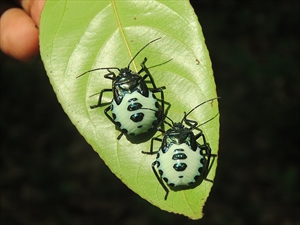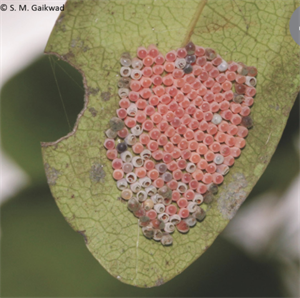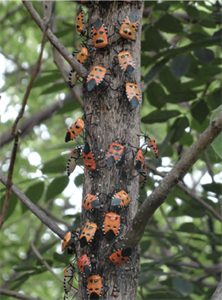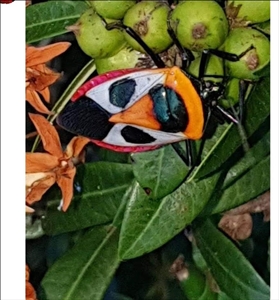Man-faced stink bug; also referred to as the Hitler bug.
Pacific Pests, Pathogens, Weeds & Pesticides - Online edition
Pacific Pests, Pathogens, Weeds & Pesticides
Man-faced stink bug (404)
Catacanthus incarnatus; also know by the name, Catacanthus nigripes. Another species, Catacanthus punctus, has been recorded from Fiji (Photo 6).
Africa (Madagascar), South and Southeast Asia, Oceania. It is recorded from New Caledonia and Papua New Guinea.
Cashew, ornamentals (e.g., Ixora), and forest trees e.g., Gmelina arborea, Delonix regia (royal poinciana) and Olea (olive) and Glochidion species.
The adults and nymphs (Photos 1-3) do the damage by sucking the sap of young shoots, damaging leaves and causing fruits to rot from secondary invasions of microorganisms.
Eggs are laid in large numbers on leaves (Photo 4), and hatch to black and white wingless nymphs (Photo 3). Adult colour is variable. There are four types: cream, orange, red and yellow, each with two pairs of large black spots on the top of the bug: one pair is on the triangular area behind the head (scutellum); and the other pair on the forewings (Photo 1). Dark,patches also occur at the tips of the forewings. It is thought that these bold colours send a signal to potential predators that the bug is poisonous, not tasty, or perhaps they just mislead predators.
Stink buds produce an aggregate pheromone that results in the bugs massing together (Photo 5). In India, large number occur on Ixora, and there are reports of 400-500 bugs on a branch of Delonix regia, and 300 on a single cashew tree.
India has reported extensive damage to cashew with 6-9 bugs on a fruit stalk, and lower yields due to infestations of the bug.
Look for the very distinctive colours of the bug, and especially the two sets of paired spots on the scutellum and forewings.
NATURAL ENEMIES
It is likely that the parasitoid wasp, Trissolcus basalis, that has successfully controlled the green vegetable bug, Nezara viridula (see Fact Sheet no. 98), will control other stink bugs. This egg parasitoid has been introduced into Australia on several occasions from different parts of the world, into Cook Islands, Hawaii, Kiribati, New Caledonia, New Zealand, Samoa, Solomon Islands, Tonga and Vanuatu, generally with positive results. However, Waterhouse & Norris (1987) suggest where it is present but ineffective, additional strains should be sought.
In many counties, ants are said to achieve high levels of biocontrol. One ant common in Pacific island countries - the big-headed ant (Pheidole megacephala) - is said to take the eggs and young nymphs to its nest.
CULTURAL CONTROL
Handpicking is a possibility on small shrubs (e.g., Ixora), but not large trees.
CHEMICAL CONTROL
Catacanthus incarnatus, like the stink bug Nezara viridula, is likely to be under control by natural enemies, and chemical control will not be needed, in fact it will destroy this control. However, if there are outbreaks, and chemical control is warranted, spray where the insects congregate, rather than the entire plant or tree canopy.
- Use plant-derived products, such as derris, pyrethrum or chilli (with the addition of soap).
- Note, a variety of Derris, brought many years ago to Solomon Islands from Papua New Guinea, is effective as a spray. It contains rotenone, an insecticide, so it should be used with caution. There may be varieties of Derris (fish poisons) in your country that can be tried (see Fact Sheet no. 56).
- Alternatively, use synthetic pyrethroids; they are likely to be effective, but will also kill natural enemies.
____________________
When using a pesticide, always wear protective clothing and follow the instructions on the product label, such as dosage, timing of application, and pre-harvest interval. Recommendations will vary with the crop and system of cultivation. Expert advice on the most appropriate pesticide to use should always be sought from local agricultural authorities.
AUTHOR Grahame Jackson
Information (and Photo 5) from Thite SV, Kore BA (2016) Mass occurrence of stink bug Catacanthus incarnatus (Dury) on Gmelina arborea Roxb. in Satara, Matarashtara. Zoo's Print xxxi (5), 8-9; and Bhat PS, Srikumar KK (2013) Occurrence of man-faced stink bug, Catacathus incarnatus Drury on cashew in Puttur region of Karnataka. Insect environment 19(1), 32-34; and from (including Photo 4) Waghmare SH et al., A case of extensive congregation of man-faced stink bug Catacanthus incarnatus (Drury) (Hemiptera: Pentatomidae) together with new host records from western Maharashtra, India. Journal of Threatened Taxa 7(8), 7490-7492. Photos 1&2 Vijayanrajapuram. Catacanthus incarnatus (Hitler Bug) mating. (https://commons.wikimedia.org/wiki/File:Hitler_bugs_-_mating_01.jpg). Photo 3 Vinayara. Catacanthus incarnatus - man-faced stink bug - nymph from Kannavam RF(6).jpg. (https://commons.wikimedia.org/wiki/File:Catacanthus_incarnatus_-_Man-faced_Stink_Bug_-_nymph_from_Kannavam_RF_(6).jpg). Photo 6 Nitya Singh, Research Officer-Plant Protection, Ministry of Agriculture, Fiji.
Produced with support from the Australian Centre for International Agricultural Research under project HORT/2016/185: Responding to emerging pest and disease threats to horticulture in the Pacific islands, implemented by the University of Queensland and the Secretariat of the Pacific Community.









